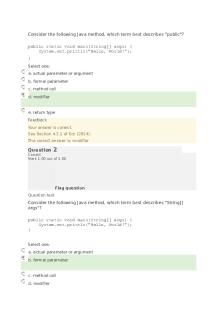Sand training has the following advantages PDF

| Title | Sand training has the following advantages |
|---|---|
| Course | Sport and Exercise Psychology |
| Institution | Mohawk College |
| Pages | 3 |
| File Size | 181 KB |
| File Type | |
| Total Downloads | 48 |
| Total Views | 132 |
Summary
Sport and Exercise Psychology Assignment 2020/2021...
Description
Sand training has the following advantages: This is a crucial subject.
The advantage of sand is the instability that requires stabilisation of the joints of the ankles, knees, hips, and lower back for constant compensation during movement. In general, sand training contributes to: When you do sand training, dry sand uses up 20% more energy than running on grass (Gian Nicola Bisciotti 2006). Max oxygen uptake improved by about 10% after 8 weeks of twice-weekly sand training, compared to training on grass. Training in the sand has a low impact force, which leads to a reduction in the possibility of injuries. Sand training improves the overall running economy for runners and other athletes who need endurance, strength, and speed. The pressure on the joints decreases when participating in sand training exercises, as it is a training programme designed to avoid the risk of many injuries, especially to the tendons. This type of training contributes to improving muscle resistance to fatigue. Sand training helps delay the onset of the milky sill.
Training in sand barefoot contributes to alerting the various areas of the foot, which are usually inactive due to wearing sports shoes.
Ruffier Dickson's test for retrieval ability: This test aims to know the recovery ability of the athlete and is an important and simple test that does not require much time and equipment.
1- Before starting the test, we measure the heart rate while resting from a sitting position (nS0). 2- Then the athlete stands with the legs slightly apart, according to the examination signal, so that the individual then bends the legs according to a specific rhythm (determined by the rhythm setting device) by performing 30 bends on the legs in a period of 45 seconds, so that the muscles of the back should touch the heel as it should be the muscles The palms of the feet are completely flush with the ground each time, keeping the torso straight and arms extended. 3- Then we measure the heart rate immediately after stopping the test (NQ1) and finally. 4- After a few minutes of rest in a sitting position, we measure the heart rate (nS2).
Ruffier index = [(n s 0 + n s 1 + n s 2)-200]/ 10
- Ruffier index < 0, excellent recall ability. - Ruffier Index [5,0] Very good retrieval ability. Ruffier Index [10.5] Good recall ability. - Ruffier index [15,10] medium recall capacity. - Ruffier index > 15, poor reproducibility....
Similar Free PDFs

Following the Correct MLA Format
- 3 Pages

The soul has bandaged moments
- 3 Pages

Laporan Praktikum Sand Cone
- 1 Pages

Sand dunes - Psammosere
- 2 Pages

Sand Sheet (latasir)
- 30 Pages

The advantages of New Technology
- 2 Pages

Sniffy report - training the rat
- 6 Pages

Georges Sand - opis, życiorys
- 5 Pages
Popular Institutions
- Tinajero National High School - Annex
- Politeknik Caltex Riau
- Yokohama City University
- SGT University
- University of Al-Qadisiyah
- Divine Word College of Vigan
- Techniek College Rotterdam
- Universidade de Santiago
- Universiti Teknologi MARA Cawangan Johor Kampus Pasir Gudang
- Poltekkes Kemenkes Yogyakarta
- Baguio City National High School
- Colegio san marcos
- preparatoria uno
- Centro de Bachillerato Tecnológico Industrial y de Servicios No. 107
- Dalian Maritime University
- Quang Trung Secondary School
- Colegio Tecnológico en Informática
- Corporación Regional de Educación Superior
- Grupo CEDVA
- Dar Al Uloom University
- Centro de Estudios Preuniversitarios de la Universidad Nacional de Ingeniería
- 上智大学
- Aakash International School, Nuna Majara
- San Felipe Neri Catholic School
- Kang Chiao International School - New Taipei City
- Misamis Occidental National High School
- Institución Educativa Escuela Normal Juan Ladrilleros
- Kolehiyo ng Pantukan
- Batanes State College
- Instituto Continental
- Sekolah Menengah Kejuruan Kesehatan Kaltara (Tarakan)
- Colegio de La Inmaculada Concepcion - Cebu







